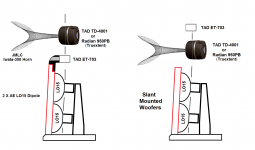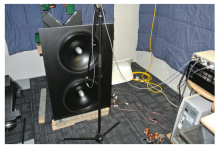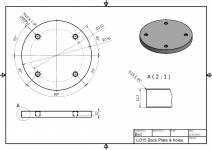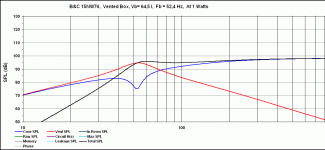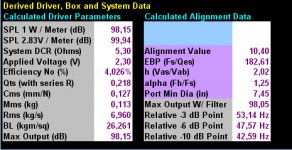POS,
Thanks for the information. As you pointed out the ET diffraction horn has the same problems that all diffraction horns have, a change with frequency that is not very smooth.
Lynn,
As far as I know the ET-703 is still an actively sold device from TAD. The problem is as you see the price, I think the $2,000 price is probably a bit low these days, at the same time I think when I got them originally they were under $400 a pair! For those who don't know what happened there was a time when the entire Be line and TAD was going to be discontinued. There were so many installed devices that there was a threat of a lawsuit if they did indeed end the line and so it was agreed that the line would continue. But the kicker was the price went from $200 per piece for the ET-703 to over $2,000 and the same with all of the rest of the line. Not making this up.
Thanks for the information. As you pointed out the ET diffraction horn has the same problems that all diffraction horns have, a change with frequency that is not very smooth.
Lynn,
As far as I know the ET-703 is still an actively sold device from TAD. The problem is as you see the price, I think the $2,000 price is probably a bit low these days, at the same time I think when I got them originally they were under $400 a pair! For those who don't know what happened there was a time when the entire Be line and TAD was going to be discontinued. There were so many installed devices that there was a threat of a lawsuit if they did indeed end the line and so it was agreed that the line would continue. But the kicker was the price went from $200 per piece for the ET-703 to over $2,000 and the same with all of the rest of the line. Not making this up.
Lynn, as far as I know the ET-703 is still an actively sold device from TAD. The problem is as you see the price, I think the $2,000 price is probably a bit low these days, at the same time I think when I got them originally they were under $400 a pair! For those who don't know what happened there was a time when the entire Be line and TAD was going to be discontinued. There were so many installed devices that there was a threat of a lawsuit if they did indeed end the line and so it was agreed that the line would continue. But the kicker was the price went from $200 per piece for the ET-703 to over $2,000 and the same with all of the rest of the line. Not making this up.
Hmm, so that's why the TAD product line keeps getting narrower and the prices continue to increase. TAD/Pioneer is trying to send a message to us.
On a more cheerful note, what do the good people of the forum think of the B&C 15NW76 bass driver? It looks as if it was intended for 2-way studio monitor use, with well-behaved response through the rolloff region, 98~100 dB/meter efficiency, and the deluxe feature of a double spider to improve centering under dynamic conditions.
Last edited:
Here are some comparative measurements of the TAD ET-703 supertweeter over at North Reading Engineering.
There's also an interesting HF/VHF combination of the Autotech Iwata 300Hz horn, Radian 950 beryllium driver, and TAD ET-703 supertweeter, complete with CLIO-measured impulse, waterfall, and FR plots.
The North Reading pages correctly display in Safari, but are mis-formatted in Chrome or Firefox. No idea how they look in the Windows version of IE.
Quick question: are the TAD ET-703's still in production, or are they another example of eBay-priced unobtanium? I ask because it seems like fewer and fewer TAD drivers are available. The only price I saw on the web was a surprising $2000 each, which is approaching ALE Acoustic or GOTO-Unit territory.
Dear Mr. Olson,
The TAD tweeters, Radian CD w/Be diaphragm, Iwata-300 horn you can see in the North Reading Engineering webpage are all mines. I ordered them such project which also includes an OB mid woofer section. All the components were stricktly selected by me, right or wrong.
This surely doesn't care anyone but let me tell you that the sole inspiration for this project was the "Beyond the Ariel" thread and the works made by JMLC.
The OB section covers 60-600Hz and I opted for double AE-LO15 the lower unit covering 60-150Hz (probably 60-300Hz) and the top one 60-600Hz.
We are now using the XM-44 active XO from Marchand for the subwoofer section (still not defined), the OB-mid woofer section and the HP for the Iwata and TAD tweeters. The XO section for the Iwata/Radian and the TAD is passive.
The job the AE-LO15 made in the OB section is terrific and they required only a 6dB/Oct EQ from 300 to 60Hz. This is what John Warren from NRE told me.
I ordered the 4 LO15 units with the back plates prepared to mount the drivers from the magnet.
The tweeter TAD is crossed to the iwata at about 8-9Khz, again in the words of NRE the disperssion of the Iwata-300 is impressive.
I attach a pic and some sketches to show what I have in mind. I intend the horn and TW section be decoupled from the OB structure, to make this in the correct way all the parts must be CNC from solid metal.
About TAD produtcs, I paid my ET-703 $ 2,900/pr (Nov-12) in Professional Audio Design. They were discontinued recently. I have followed the supply of this brand for several years now and many of their CD were in and out of production several times. Impossible to say if the discontinuity of the ET-703 is definitive.
There is indeed an issue with the original small horn in front of the ET-703, it does not like to a lot of fellows. There is a group in France that made a solid horn with the assistance of JMLC. Something similar to what this German TAD supplier is offering :
"http://www.hornfabrik-eder.de/hochtonhorn.htm".
I have the feeling that this TW will perform much better with this kind of solid metal horn but given my ignorance I can't tell why.
I do know the overal architecture of this project will not please someones but I won't change it. I personally love dipoles (especially in the mid-woofer section), I love electric XO's, I don't care using operational amplifiers and EQ. I already verified in my phono-tests the last family of OptoAmps are indistinguishable from discretes (especially in TO99 package). It looks like I will be the only one that will stick to the original concept how this thread was born.
I would like to express my gratitude to Mr. Olson, the memory of JMLC, Gary, Mr. Geddes and all the fellows that contributed to this thread with their knowledge as Pooh, Line Source, Pos, Truetone and so many more. I am sure that almost all of the interactions of speakers mentioned here will sound much better that the normal commercial speakers including those sold for small fortunes but performing as insults.
Thanks.
Attachments
Dear Mr. Olson,
The TAD tweeters, Radian CD w/Be diaphragm, Iwata-300 horn you can see in the North Reading Engineering webpage are all mines. I ordered them such project which also includes an OB mid woofer section. All the components were stricktly selected by me, right or wrong.
This surely doesn't care anyone but let me tell you that the sole inspiration for this project was the "Beyond the Ariel" thread and the works made by JMLC. SNIP
Thanks.
I really like your system. My second choice in midbass is the open baffle and it does have advantage over horn loaded in my experience. If my room were any smaller then it is now I'd be listening to bass on a board
I am intrigued by the IWATA horn, someday I hope to hear a pair.
Very nice!
Last edited:
Great information guys. I have to say though many of us have differing ways to approach our speakers and many different implementations and drivers we all seem to chase the best methods for each concept. Whether we are DHT fans or DSP Xo fans we do seem to do our homework on how to do it best. Just reading these threads has reignited my thinking and for the first time in years I am thinking about horns again. With some of the newer drivers and some of the legacy devices like the TAD ET703 I think I will finish some of the product I have kept in storage and paid good money to do that for someone who can appreciate that type of system. Keep up the great work, hopefully Lynn will actually have himself a finished system sooner than later. I say seven years is probably long enough for development!
Great information guys. I have to say though many of us have differing ways to approach our speakers and many different implementations and drivers we all seem to chase the best methods for each concept. Whether we are DHT fans or DSP Xo fans we do seem to do our homework on how to do it best. Just reading these threads has reignited my thinking and for the first time in years I am thinking about horns again. With some of the newer drivers and some of the legacy devices like the TAD ET703 I think I will finish some of the product I have kept in storage and paid good money to do that for someone who can appreciate that type of system. Keep up the great work, hopefully Lynn will actually have himself a finished system sooner than later. I say seven years is probably long enough for development!
I think this thread is beyond focusing where it initially did. It's now about all you who are at the top of this field and willing to share. It's about Alchemy. We've been given bits and drabs of many systems and hope for more.
I think it's great that we look beyond, beyond the Ariel here for a few more years,
Thank you all,
Ron
I am sure that almost all of the [iterations] of speakers mentioned here will sound much better that the normal commercial speakers including those sold for small fortunes but performing as insults.

You have done a beautiful job on your speakers! Congratulations and thank you for sharing.
Gary Dahl
Last edited:
On a more cheerful note, what do the good people of the forum think of the B&C 15NW76 bass driver? It looks as if it was intended for 2-way studio monitor use, with well-behaved response through the rolloff region, 98~100 dB/meter efficiency, and the deluxe feature of a double spider to improve centering under dynamic conditions.
I don't like it
It looks like the n-th iteration of the "modern" PA-spec'd woofer that is meant to take a lot of abuse without biting the dust.
Two numbers say it all to me:
Fs/Qts = 198. OK, so this is a mid-bass, not a woofer. No hope of getting it to produce much bass at all below 80 Hz or so...
Rms = 6.5 (back-calculated from Qms). Very high mechanical resistance / stiction. It will surely sound "dead" and lacking in micro-dynamics, especially when played at home levels (it might sound OK at ear-splitting PA levels...)
I bet it'll sound somewhat similar to the JBL 2226H (Fs/Qt = 130, Rms = 5), which IIRC you tried and did not like compared to the GPA 416-8B... only probably even worse!
So VERY different from those woofers that I know from experience actually do sound very good, e.g.:
TAD TL-1601a: Fs/Qt = 82, Rms = 3.0
Fostex FW-405N: Fs/Qt = 60, Rms = 2.5
Marco
Last edited:
High mechanical resistance is probably a consequence of using a double spider. Not necessarily a problem in a sub, but I'm not sure I'd want one up higher. I think that the lightness and flexibility of the spider in the Altec/GPA woofer contributes greatly to its subjective responsiveness.
Gary Dahl
Gary Dahl
Of interest may be GM's comments on the Supravox vs the JBL 2226 mms here :
http://www.diyaudio.com/forums/multi-way/83648-811b-806a-16ohm-jbl-2226-supravox-285-gmf.html
http://www.diyaudio.com/forums/multi-way/83648-811b-806a-16ohm-jbl-2226-supravox-285-gmf.html
Thanks - not sure if that's useful . I've never heard the JBL's , but I suspect GM has never heard the 285GMF . I have - they are the bass speaker in my friend JamesD's 'Quasar' OB's, which are generally the best speakers I've ever heard, plus I owned a pair myself until very recently. I wish I'd never sold them on - they were superb bass/mid drivers, and very good at low levels .
What's the Rms on the JBL's ? ( I can calc on Hornresp tomorrow perhaps ) .
edit : Rms 5.04 for the 2226J ...
What's the Rms on the JBL's ? ( I can calc on Hornresp tomorrow perhaps ) .
edit : Rms 5.04 for the 2226J ...
Last edited:
I appreciate your comments, Marco. I was genuinely surprised by a direct comparison of the JBL 2226 and the Great Plains Audio 416-Alnico. I thought they would sound the same; they're both in the piston range, 60 Hz to 700 Hz, and IM distortion from the driver is very low at triode-amplifier power levels. If anything, the JBL should sound better, with a much more modern design and all the clever distortion-reduction tricks of the trade.
But that's not what I heard. The tone colors of the GPA 416-Alnico were much more vivid, and the bass was more realistic and in-the-room than any driver I'd heard before. Adding in a dose of 2nd and 3rd-harmonic distortion would not do what I heard ... it would take the sound in the other direction. Granted, I haven't heard them all, but I've heard more than a few, and this was the best, and most musically satisfying, bass driver I've heard to date. Gary Dahl seems to concur, based on what he's told me over the phone.
Again, this is all in the piston range, where the response is flat, and energy storage is from the cabinet, not the driver. By rights, the drivers should have sounded pretty close to identical. But they didn't. Not at all. They were more different than different brands of compression drivers, which is not what I expected. I'm still reflecting on why direct-radiator bass drivers, working in the piston band with flat response and no equalization, can sound so different.
Marco, thanks for the suggestions about the TAD TL-1601a and Fostex FW-405N. I really like the GPA 416-Alnico, but I should also audition the other two as well. I should audition the Kilimanjaro field-coil version of the 416 ... but I remain unconvinced that field coils are "better" than Alnico. My preliminary listening tells me they are different in a way that's kind of hard to describe. I could be wrong, of course. My expectation that the JBL 2226 and the GPA 416-Alnico would sound the same was certainly confounded.
But that's not what I heard. The tone colors of the GPA 416-Alnico were much more vivid, and the bass was more realistic and in-the-room than any driver I'd heard before. Adding in a dose of 2nd and 3rd-harmonic distortion would not do what I heard ... it would take the sound in the other direction. Granted, I haven't heard them all, but I've heard more than a few, and this was the best, and most musically satisfying, bass driver I've heard to date. Gary Dahl seems to concur, based on what he's told me over the phone.
Again, this is all in the piston range, where the response is flat, and energy storage is from the cabinet, not the driver. By rights, the drivers should have sounded pretty close to identical. But they didn't. Not at all. They were more different than different brands of compression drivers, which is not what I expected. I'm still reflecting on why direct-radiator bass drivers, working in the piston band with flat response and no equalization, can sound so different.
Marco, thanks for the suggestions about the TAD TL-1601a and Fostex FW-405N. I really like the GPA 416-Alnico, but I should also audition the other two as well. I should audition the Kilimanjaro field-coil version of the 416 ... but I remain unconvinced that field coils are "better" than Alnico. My preliminary listening tells me they are different in a way that's kind of hard to describe. I could be wrong, of course. My expectation that the JBL 2226 and the GPA 416-Alnico would sound the same was certainly confounded.
Last edited:
Lynn,
It is so many things that will change the sound. The differences in paper used in the cone. the adhesives used at each and every connection, former to cone, spider to former and cone to surround make more differences than many will readily acknowledge and then we have the treatment and type of former, Kapton is very common but the thickness and the addition of a simple Tufquin damping layer changes things. The treatment of the surround and spider can be very different also and each manufacturer seems to have their own secrets sauce. You can build two speakers with the same basic design and similar components and end up hearing just what you are describing, two speakers you would think should sound the same and sound very different. It is all in the details.
It is so many things that will change the sound. The differences in paper used in the cone. the adhesives used at each and every connection, former to cone, spider to former and cone to surround make more differences than many will readily acknowledge and then we have the treatment and type of former, Kapton is very common but the thickness and the addition of a simple Tufquin damping layer changes things. The treatment of the surround and spider can be very different also and each manufacturer seems to have their own secrets sauce. You can build two speakers with the same basic design and similar components and end up hearing just what you are describing, two speakers you would think should sound the same and sound very different. It is all in the details.
The dreadful part is when a driver vendor makes a production change without notifying the loudspeaker manufacturer or the hapless DIY builder. I've suspected for a long time that the "special" OEM versions made for famous-name XYZ manufacturer aren't special at all ... it's just a version that's exempted from the usual production-speedup driver-vendor production changes. Most of the time.
But the big guys probably still get unwanted surprises, which of course necessitates annoying (and expensive) changes in the production crossover so the final product still has the "house" sound ... well, the changes get made in time for the next session with a magazine reviewer, at any rate.
The adhesives alone must make huge subjective differences, some of which would be (easily) measurable, and others much harder to detect in the impulse, CSD or swept-distortion measurements. Nothing that would show in the visual appearance of the driver at all.
The critical VC former-to-cone adhesive joint experiences very high "G" forces, and has the additional awkward task of transforming acceleration forces through the angle between the former and the cone. Lots of room for trouble in one innocent-looking adhesive joint.
The former to spider, and cone to surround, have the interesting task of efficiently damping the high-acceleration structures, suppressing rocking motions, and lasting for a long time while exposed to environmental abuse. A lot of tradeoffs between speed of production assembly (drying time), durability, power-handling, environmental regulations, etc. etc. No surprise that subjective sonic qualities (that are hard to measure) can end up at the bottom of the list.
But the big guys probably still get unwanted surprises, which of course necessitates annoying (and expensive) changes in the production crossover so the final product still has the "house" sound ... well, the changes get made in time for the next session with a magazine reviewer, at any rate.
The adhesives alone must make huge subjective differences, some of which would be (easily) measurable, and others much harder to detect in the impulse, CSD or swept-distortion measurements. Nothing that would show in the visual appearance of the driver at all.
The critical VC former-to-cone adhesive joint experiences very high "G" forces, and has the additional awkward task of transforming acceleration forces through the angle between the former and the cone. Lots of room for trouble in one innocent-looking adhesive joint.
The former to spider, and cone to surround, have the interesting task of efficiently damping the high-acceleration structures, suppressing rocking motions, and lasting for a long time while exposed to environmental abuse. A lot of tradeoffs between speed of production assembly (drying time), durability, power-handling, environmental regulations, etc. etc. No surprise that subjective sonic qualities (that are hard to measure) can end up at the bottom of the list.
Last edited:
As a carpenter looking at the work a low frequency loudspeaker has to do, the notion of load path comes to mind. In particular the voice coil former to cone junction, then the cone itself, then the cone to surround. In the background there are parallel load paths from magnet structure through the frame or basket to the baffle, the point at which the push-pull of this device terminates - sort of; the baffle itself has its issues. This is a multitude of resonances, and the way they stack up accounts for the differences between what would seem to be near clones, as in the JBL/Altec example.
I'm still reflecting on why direct-radiator bass drivers, working in
the piston band with flat response and no equalization, can sound so
different.
Suspension makes the difference.
- Home
- Loudspeakers
- Multi-Way
- Beyond the Ariel
